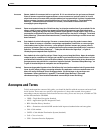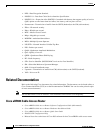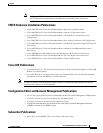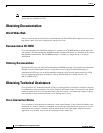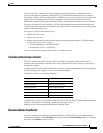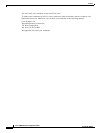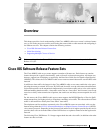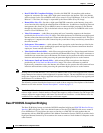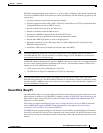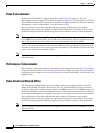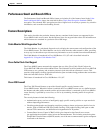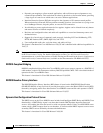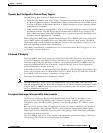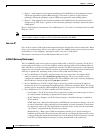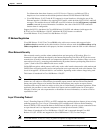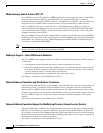
1-3
Cisco uBR924 Software Configuration Guide
OL-0337-05 (8/2002)
Chapter 1 Overview
Cisco IOS Software Release Feature Sets
DOCSIS-compliant bridging (also referred to as “plug-and-play” bridging) is the default configuration
for the Cisco uBR924 router. In this mode, the router automatically does the following at power-on and
system reset:
• Acquires temporary downstream and upstream channels
• Finds the appropriate Time of Day (ToD), Trivial File Transfer Protocol (TFTP), and Dynamic Host
Configuration Protocol Server (DHCP) servers
• Gets the current time of day from the ToD server
• Obtains an IP address from the DHCP server
• Downloads a DOCSIS configuration file from the TFTP server
• Configures itself for its permanent downstream and upstream channels
• Obtains other DHCP parameters to work in bridging mode
• Optionally downloads a Cisco IOS image and Cisco IOS configuration file if specified in the
DOCSIS configuration file
• Establishes a BPI session (if enabled on both the router and CMTS)
Note The Base IP Bridging feature set is the default image for the Cisco uBR924 cable access router in
Cisco IOS Release 12.0. It is not available as a separate image in Cisco IOS Release 12.1 because is
incorporated in all other available images.
In DOCSIS-compliant bridging mode, the Cisco uBR924 cable access router acts as a transparent bridge
for one or more customer premises equipment (CPE) devices. The maximum number of CPE devices
depends on the Cisco IOS Release being used:
• 3 CPE devices using Cisco IOS Release 12.0(4) XI1
• 254 CPE devices using Cisco IOS Release 12.0(5)T or later images
Note The maximum number of CPE devices also depends on the value of the “MAX CPE” field in the
DOCSIS configuration file. The MAX CPE field defaults to one CPE device unless set otherwise. In this
situation, the Cisco uBR924 router can connect only one computer to the cable network, regardless of
the Cisco IOS Release being used.
Home Office (Easy IP)
The Home Office feature set provides high-speed Internet connectivity for customers who have a small
home network. In addition to full DOCSIS 1.0 support (see Base IP DOCSIS-Compliant Bridging), the
Home Office feature set provides the Easy IP set of features that simplifies the administration of IP
addresses in a cable network.
This feature set supports intelligent Dynamic Host Configuration Protocol Server (DHCP) functions,
such as DHCP Relay Agent and DHCP Client functionality. It also supports Network Address
Translation and Port Address Translation (NAT/PAT).
The DHCP features provide intelligence and flexibility in the handling and distribution of IP addresses
for the PCs and other CPE devices being connected to the cable network. The NAT/PAT features allow
the customer to use private IP addresses on the local network, while still maintaining connectivity to the
Internet.



